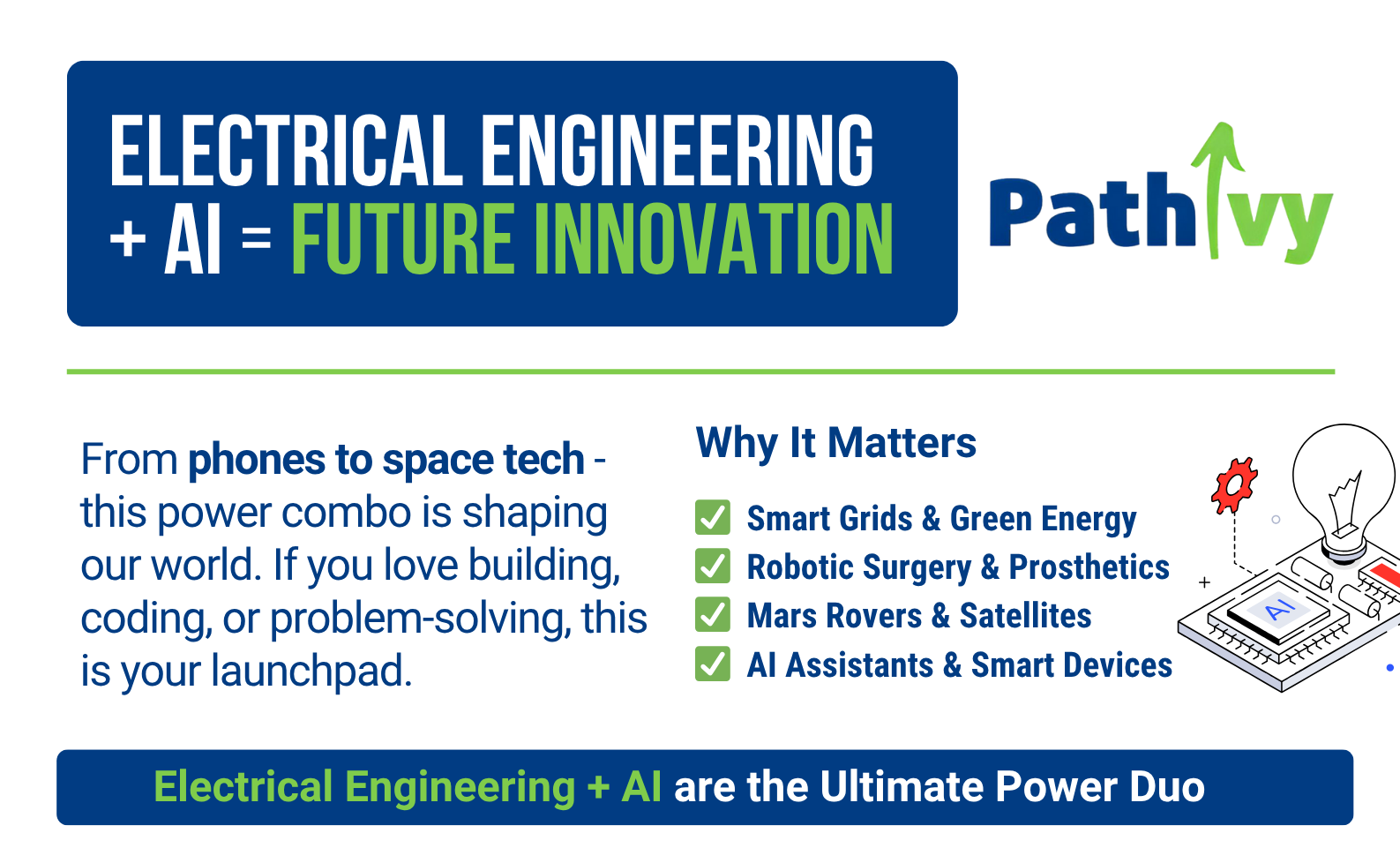In a world where your phone unlocks with your face, cars park themselves, and homes adjust their lighting with your mood, have you ever stopped to ask how it all works?
The answer often lies in the intersection of Electrical Engineering (EE) and Artificial Intelligence (AI).
If you’re a high school student curious about science, technology, or building cool things, read on—this is your blueprint for the future.
What Is Electrical Engineering (EE)?
Electrical Engineering is the study and application of electricity, electronics, and electromagnetism. It powers nearly every modern innovation, from smartphones to solar panels.
Electrical engineers design and build:
- Microchips (like the M1 or Snapdragon in your phone)
- Circuits and sensors (that detect temperature, pressure, motion)
- Motors and batteries (used in electric vehicles and drones)
- Power systems (from smart grids to solar inverters)
Real-World EE in Action:
- Phones: Engineers create compact, high-speed circuitry.
- Drones: EE controls flight systems and sensor communication.
- Medical Devices: Pacemakers, EEGs, and MRI machines are all EE marvels.
- Green Tech: Smart grid controllers and renewable energy systems.
What Is Artificial Intelligence (AI)?
AI is about making computers smart, so they can learn, adapt, and make decisions. Rather than being programmed step-by-step, AI uses data to learn patterns and make predictions.
Common types of AI:
- Machine Learning (ML) – Predict outcomes from data
- Computer Vision – Interpret visual inputs
- Natural Language Processing (NLP) – Understand and generate text/speech
- Reinforcement Learning – Trial-and-error learning used in robotics and games
AI in Everyday Life:
- Siri recognizes your voice
- Netflix recommends what you like
- Self-driving cars detect people and traffic signs

Why EE and AI Work Better Together
Here’s the truth: AI can’t run without hardware, and that’s where EE shines.
|
Field |
Electrical Engineering Role |
AI’s Role |
|
Robotics |
Motors, sensors, power systems |
Learning, perception, control |
|
Autonomous Vehicles |
Lidar, radar, control boards |
Object detection, path planning |
|
Smart Homes |
Circuits, wireless networks |
Behavior prediction, automation |
|
Healthcare Tech |
EEGs, wearables, imaging tools |
Diagnostic models, anomaly detection |
Think of it this way: EE builds the body, AI provides the brain.
Why This Combo Matters for the Future
- Climate and Energy
AI helps optimize smart grids, and EE builds solar, wind, and battery systems. - Healthcare
Smart prosthetics, early diagnostics, and robotic surgery rely on AI+EE synergy. - Space Exploration
Mars rovers use AI for autonomy and EE to survive space conditions. - Everyday Innovation
From smart fridges to voice assistants to AI tutors, everyday tech is evolving fast.
How to Get Started in High School
Classes That Help:
- Math: Algebra, Calculus, Statistics
- Science: Physics (esp. electricity & magnetism), Chemistry
- Computer Science: AP CS A or Principles
- Engineering: Robotics, Engineering Design, Electronics (if available)
Hands-On Projects:
- Build with Arduino or Raspberry Pi (motion sensor, smart alarm)
- Try a line-following robot
- Use Google Teachable Machine or TensorFlow to train a model
Learn AI & EE Online:
- Elements of AI (beginner-friendly)
- fast.ai (hands-on ML)
- MIT OpenCourseWare – Circuits & Electronics (college-level intro)
Competitions & Programs
Entering challenges builds your skills and helps you stand out on college apps.
- FIRST Robotics or VEX Robotics
- Regeneron ISEF, local science fairs
- AI for Good hackathons (e.g., Zindi, Kaggle)
- Nova Research and Nova Patent programs
- Conrad Challenge, MIT THINK, Technovation, and more
Career Paths That Combine EE and AI
|
Career |
What They Do |
|
AI Hardware Engineer |
Build chips for machine learning (e.g., NVIDIA, Intel) |
|
Robotics Engineer |
Design autonomous robots for medicine, space, or industry |
|
Biomedical Engineer |
Create AI-driven medical devices and imaging tools |
|
Renewable Energy Engineer |
Use AI to optimize solar/wind performance |
|
Product Manager |
Lead teams creating AI-powered tech products |
Top 10 U.S. Electrical Engineering Schools at a Glance (EduRank 2025)
|
Rank |
School |
AI Lab |
Cool Fact |
|
1️⃣ |
MIT |
Created the first wearable computer |
|
|
2️⃣ |
Stanford |
Coined the term “AI” |
|
|
3️⃣ |
UC Berkeley |
Founded RISC-V processor architecture |
|
|
4️⃣ |
Georgia Tech |
Major hub for robotics + ethics |
|
|
5️⃣ |
U. of Michigan |
Strong research in robotics & health tech |
|
|
6️⃣ |
UIUC |
Alumni founded YouTube & PayPal |
|
|
7️⃣ |
UCLA |
Site of the first internet node |
|
|
8️⃣ |
UT Austin |
Collaborates with Tesla & Dell |
|
|
9️⃣ |
Penn State |
AI in agriculture, energy & materials |
|
|
🔟 |
Caltech |
Research in physics + quantum AI |
Final Thought: You’re Not Too Young to Start
If you love taking things apart, coding, inventing, or imagining future tech, you’re already on the right track.
You don’t need a fancy lab, just curiosity and a willingness to try. Start with an Arduino kit. Play with AI in Colab. Read a circuit diagram. Learn something new every week.
The future isn’t waiting, it’s being built by students just like you. And it’s wired with EE and powered by AI.
.png?width=175&height=73&name=ORIGINAL%20LOGO%20Blue%20and%20Green%20(1).png)
.png?width=50&name=author-image%20(2).png)

